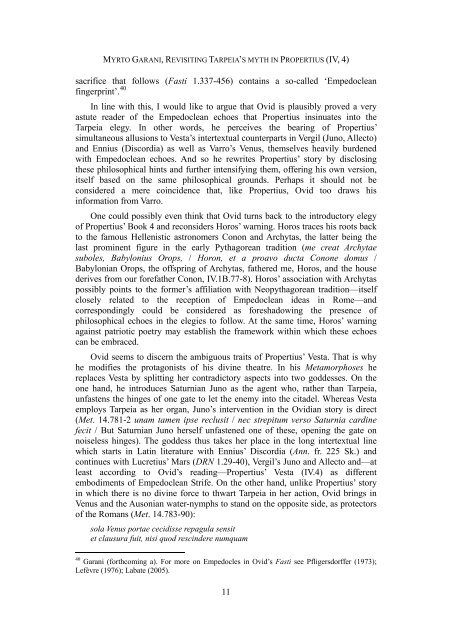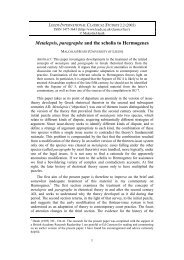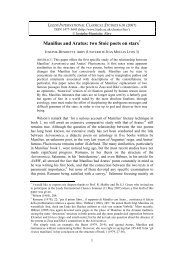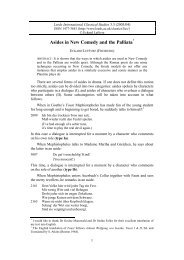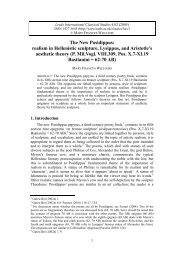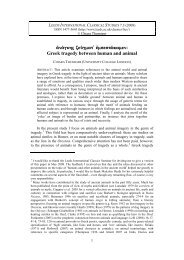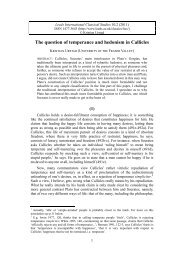Revisiting Tarpeia's myth in Propertius (IV, 4) - Leeds International ...
Revisiting Tarpeia's myth in Propertius (IV, 4) - Leeds International ...
Revisiting Tarpeia's myth in Propertius (IV, 4) - Leeds International ...
Create successful ePaper yourself
Turn your PDF publications into a flip-book with our unique Google optimized e-Paper software.
MYRTO GARANI, REVISITING TARPEIA’S MYTH IN PROPERTIUS (<strong>IV</strong>, 4)<br />
sacrifice that follows (Fasti 1.337-456) conta<strong>in</strong>s a so-called ‘Empedoclean<br />
f<strong>in</strong>gerpr<strong>in</strong>t’. 40<br />
In l<strong>in</strong>e with this, I would like to argue that Ovid is plausibly proved a very<br />
astute reader of the Empedoclean echoes that <strong>Propertius</strong> <strong>in</strong>s<strong>in</strong>uates <strong>in</strong>to the<br />
Tarpeia elegy. In other words, he perceives the bear<strong>in</strong>g of <strong>Propertius</strong>’<br />
simultaneous allusions to Vesta’s <strong>in</strong>tertextual counterparts <strong>in</strong> Vergil (Juno, Allecto)<br />
and Ennius (Discordia) as well as Varro’s Venus, themselves heavily burdened<br />
with Empedoclean echoes. And so he rewrites <strong>Propertius</strong>’ story by disclos<strong>in</strong>g<br />
these philosophical h<strong>in</strong>ts and further <strong>in</strong>tensify<strong>in</strong>g them, offer<strong>in</strong>g his own version,<br />
itself based on the same philosophical grounds. Perhaps it should not be<br />
considered a mere co<strong>in</strong>cidence that, like <strong>Propertius</strong>, Ovid too draws his<br />
<strong>in</strong>formation from Varro.<br />
One could possibly even th<strong>in</strong>k that Ovid turns back to the <strong>in</strong>troductory elegy<br />
of <strong>Propertius</strong>’ Book 4 and reconsiders Horos’ warn<strong>in</strong>g. Horos traces his roots back<br />
to the famous Hellenistic astronomers Conon and Archytas, the latter be<strong>in</strong>g the<br />
last prom<strong>in</strong>ent figure <strong>in</strong> the early Pythagorean tradition (me creat Archytae<br />
suboles, Babylonius Orops, / Horon, et a proavo ducta Conone domus /<br />
Babylonian Orops, the offspr<strong>in</strong>g of Archytas, fathered me, Horos, and the house<br />
derives from our forefather Conon, <strong>IV</strong>.1B.77-8). Horos’ association with Archytas<br />
possibly po<strong>in</strong>ts to the former’s affiliation with Neopythagorean tradition—itself<br />
closely related to the reception of Empedoclean ideas <strong>in</strong> Rome—and<br />
correspond<strong>in</strong>gly could be considered as foreshadow<strong>in</strong>g the presence of<br />
philosophical echoes <strong>in</strong> the elegies to follow. At the same time, Horos’ warn<strong>in</strong>g<br />
aga<strong>in</strong>st patriotic poetry may establish the framework with<strong>in</strong> which these echoes<br />
can be embraced.<br />
Ovid seems to discern the ambiguous traits of <strong>Propertius</strong>’ Vesta. That is why<br />
he modifies the protagonists of his div<strong>in</strong>e theatre. In his Metamorphoses he<br />
replaces Vesta by splitt<strong>in</strong>g her contradictory aspects <strong>in</strong>to two goddesses. On the<br />
one hand, he <strong>in</strong>troduces Saturnian Juno as the agent who, rather than Tarpeia,<br />
unfastens the h<strong>in</strong>ges of one gate to let the enemy <strong>in</strong>to the citadel. Whereas Vesta<br />
employs Tarpeia as her organ, Juno’s <strong>in</strong>tervention <strong>in</strong> the Ovidian story is direct<br />
(Met. 14.781-2 unam tamen ipse reclusit / nec strepitum verso Saturnia card<strong>in</strong>e<br />
fecit / But Saturnian Juno herself unfastened one of these, open<strong>in</strong>g the gate on<br />
noiseless h<strong>in</strong>ges). The goddess thus takes her place <strong>in</strong> the long <strong>in</strong>tertextual l<strong>in</strong>e<br />
which starts <strong>in</strong> Lat<strong>in</strong> literature with Ennius’ Discordia (Ann. fr. 225 Sk.) and<br />
cont<strong>in</strong>ues with Lucretius’ Mars (DRN 1.29-40), Vergil’s Juno and Allecto and—at<br />
least accord<strong>in</strong>g to Ovid’s read<strong>in</strong>g—<strong>Propertius</strong>’ Vesta (<strong>IV</strong>.4) as different<br />
embodiments of Empedoclean Strife. On the other hand, unlike <strong>Propertius</strong>’ story<br />
<strong>in</strong> which there is no div<strong>in</strong>e force to thwart Tarpeia <strong>in</strong> her action, Ovid br<strong>in</strong>gs <strong>in</strong><br />
Venus and the Ausonian water-nymphs to stand on the opposite side, as protectors<br />
of the Romans (Met. 14.783-90):<br />
sola Venus portae cecidisse repagula sensit<br />
et clausura fuit, nisi quod resc<strong>in</strong>dere numquam<br />
40<br />
Garani (forthcom<strong>in</strong>g a). For more on Empedocles <strong>in</strong> Ovid’s Fasti see Pfligersdorffer (1973);<br />
Lefèvre (1976); Labate (2005).<br />
11


